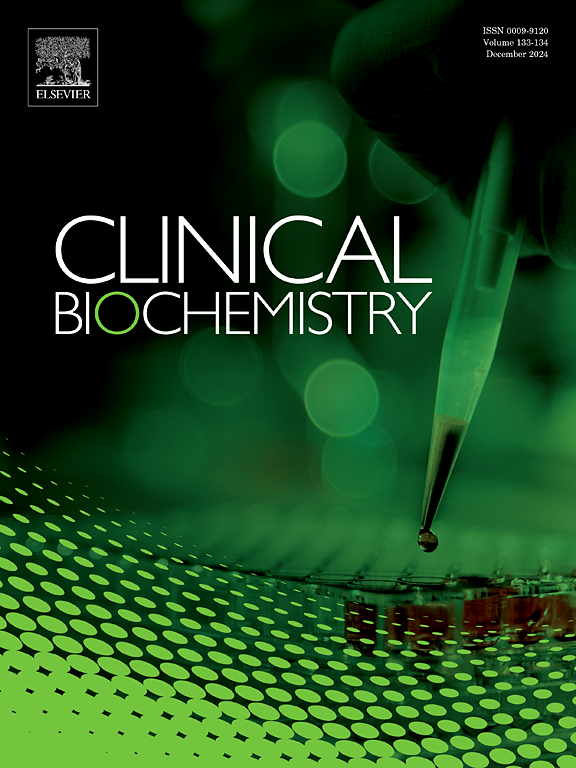低真空(3 mL)快速血清管比急诊科收集的血浆分离管能更好地防止溶血。
IF 2.1
3区 医学
Q2 MEDICAL LABORATORY TECHNOLOGY
引用次数: 0
摘要
导读:溶血是干扰实验室检测的主要来源,特别是对急诊科(ED),导致检测结果的周转时间更长,重复抽血,延迟护理提供,并增加医院费用。与血浆分离管(PST)相比,快速血清管(RST)可以减少运输引起的溶血,特别是通过气动管系统发送的样本。以前,测试RST疗效的研究使用了更大体积的5 mL管,而4.5 mL PST管。在这项研究中,较低的真空RST(3 mL)与PST(3.5 mL)相比,可以减少溶血。方法:选取47例ED患者的PST和RST配对血样进行研究。RST和PST样品通过气动管系统发送,并在离心前检查凝块程度。所有样品在一小时内检测高敏肌钙蛋白(hs-cTnT)、溶血、乳酸脱氢酶和钾。结果:与PSTs相比,完全凝血的RSTs溶血程度显著降低(p = 0.0005)。在仅部分凝血的rst和pst中,溶血率差异无统计学意义(p = 0.273)。RST和PST中hs-cTnT水平一致,斜率为0.96,截距为1.01 ng/L, r平方值为0.9318。结论:与低真空PSTs或部分凝固的RSTs相比,完全凝固的低真空RSTs对运输诱导的溶血具有更好的保护作用。与先前研究的大容量RSTs相比,低真空RSTs也提供了更多的溶血保护。转运前的血栓形成是RST保护机制的关键。鼓励血液设备制造商开发低真空RST用于ED和其他高溶血率的领域。本文章由计算机程序翻译,如有差异,请以英文原文为准。
Low vacuum (3 mL) rapid serum tubes offer better protection from hemolysis than plasma separator tubes collected in the emergency department
Introduction
Hemolysis is a major source of interference with laboratory testing, especially for the emergency department (ED), leading to longer turnaround times for test results, repeated blood draws, delay in care delivery, and increased hospital costs. Rapid serum tubes (RST) can reduce transport-induced hemolysis, especially for samples sent via the pneumatic tube system, as compared with plasma separator tubes (PST). Previously, studies testing the efficacy of RST used larger volume 5 mL tubes to compare to 4.5 mL PST tubes. In this study, a lower vacuum RST (3 mL) is compared to PST (3.5 mL) for hemolysis reduction.
Methods
Paired PST and RST blood samples from 47 ED patients were included in this study. RST and PST samples were sent via the pneumatic tube system and inspected for degree of clotting prior to centrifugation. All samples were tested within the hour for high-sensitivity troponin (hs-cTnT), hemolysis, lactate dehydrogenase, and potassium.
Results
Degree of hemolysis was significantly lower in fully clotted RSTs compared to PSTs (p = 0.0005). In RSTs that only partially clotted and PSTs, differences in hemolysis rates were non-significant (p = 0.273). The hs-cTnT levels in RST and PST are concordant with a slope of 0.96, an intercept of 1.01 ng/L and an R-squared value of 0.9318.
Conclusion
Fully clotted low-vacuum RSTs provide improved protection from transport-induced hemolysis compared to low-vacuum PSTs or partially clotted RSTs. Low-vacuum RSTs also provided more hemolysis protection than larger volume RSTs previously studied. Clot formation prior to transport is key to the protective mechanism of RST. Blood device manufacturers are encouraged to develop low vacuum RST for use by the ED and other areas with high hemolysis rates.
求助全文
通过发布文献求助,成功后即可免费获取论文全文。
去求助
来源期刊

Clinical biochemistry
医学-医学实验技术
CiteScore
5.10
自引率
0.00%
发文量
151
审稿时长
25 days
期刊介绍:
Clinical Biochemistry publishes articles relating to clinical chemistry, molecular biology and genetics, therapeutic drug monitoring and toxicology, laboratory immunology and laboratory medicine in general, with the focus on analytical and clinical investigation of laboratory tests in humans used for diagnosis, prognosis, treatment and therapy, and monitoring of disease.
 求助内容:
求助内容: 应助结果提醒方式:
应助结果提醒方式:


